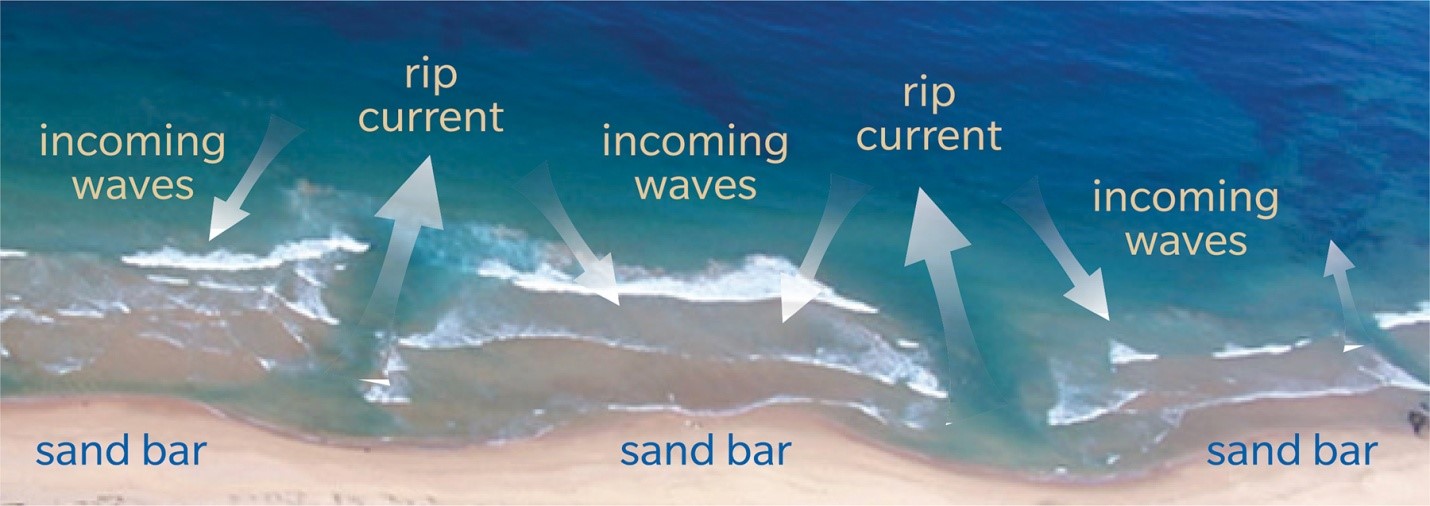Description

Disclaimer: Copyright infringement not intended.
Context
Indian National Centre for Ocean Information Services (INCOIS) and Indian Space Research Organisation (ISRO) have embarked on a project to continuously monitor and issue operational forecast alerts of rip currents.
Details
Rip current
- A rip current is a strong flow of water running from a beach back to the open ocean, sea, or lake.
- They can be more than 45 meters (150 feet) wide, but most are less than 9 meters (30 feet). They can move at 8 kilometers (5 miles) per hour.
- Rip currents are one of the most dangerous natural hazards in the world
Undertows and Rip currents
- Rip currents are sometimes confused with undertows.
- Undertows are also currents, but they run along the ocean floor and can pull beachgoers beneath the waters surface.
- Rip currents run along the surface of the water, and do not pose the same hazard.
- Rip currents are also known as rip tides. This is an inaccurate name. Strong tides, especially low tides, can contribute to the strength of a rip current, but rip currents really have nothing to do with tides. Rip currents can occur on almost any beach with breaking waves.

Rip Current Formation
- Rip currents are formed by a beachs topography. Topography is the surface features of an area.
- Rip currents can occur in areas with hard-bottom (rocky) or soft-bottom (sand or silt) beach topography.
- A beachs topography includes the area outside the water, such as dunes or marshes. Beach topography also includes the area within the water, like sandbars, piers, and reefs. Rip currents often form around these parts of a beachs topography.
- It can form in a gap between sandbars, piers, or parts of a reef. Such underwater obstacles block waves from washing directly back to sea. The water from these waves, called feeder waves, runs along the shore until it finds an opening around the obstacle.
- The stream of water, now a rip current, rushes to the opening, just like water down a drain. It flows more quickly than the water on either side of it, and may stir up sediment from the beach.
- This sometimes makes rip currents easy to spot as dark or muddy lines running from the beach out toward the ocean.
- Rip currents are also usually more calm-looking than the surrounding water. Once past the obstacle (between the sandbars or piers), a rip current loses pressure and stops flowing.
- Beaches without breaking waves, like those on most lakes or rivers, do not have rip currents. Every beach with breaking waves, including beaches on large lakes like Lake Superior in North America, can develop rip currents.
- Beaches that suffer from strong weather patterns, like hurricanes, can develop the most dangerous rip currents. As hurricanes develop far out at sea, they create strong waves that crash into the shore with great force. These waves can build up sandbars and create inshore holes.
- Inshore holes are deep depressions in the ocean bottom. Strong waves, deep inshore holes, and sandbars can create powerful rip currents. In places like western Australia and the U.S. state of Florida, strong rip currents are one of the first signs of an approaching hurricane.
Significance for Study
- The strength of rip currents can be seasonal. During hurricane/cyclone season there is a greater chance for rip currents to develop. The Rip Current Outlook advises swimmers of the risk (high, moderate, or low) of rip currents on an areas beaches.
- Surfers often take advantage of rip currents for a ride out to sea. Rather than using energy to paddle, they will find a rip current and coast along on their surfboard.
- Rip currents pose significant dangers to swimmers, surfers, and beachgoers. They can swiftly carry unsuspecting individuals away from the shore and into deeper water, where they may struggle against the current and become exhausted. Rip currents are responsible for a large proportion of drownings at beaches worldwide.

Conclusion
- Understanding the dynamics and dangers of rip currents is essential for coastal safety and enjoyment, as they are a natural and common feature of coastal environments worldwide.
|
PRACTICE QUESTION
What is a rip current?
- A strong ocean wave
- A narrow, powerful flow of water moving away from the shore
- A gentle current that pulls swimmers toward the shore
- A type of tidal wave often seen during high tide
Answer B
|














